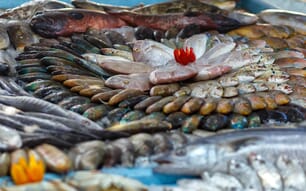More than three billion people on the planet depend on seafood for a critical portion of their diet’s protein. In the US, we import nearly 90% of our seafood, reaching across the globe to the waters of developing nations to buy their tastiest and most exotic fish. Worldwide, the voracious appetite for fish has shamefully depleted our oceans, overexploiting stocks and destroying marine habitats.
To keep pace with the growing demand for seafood—predicted to rise 8% during the next decade—the world must increasingly rely on aquaculture, the farming of fish.
Unfortunately, though it is a prevalent and important solution to the shortage of wild fish, aquaculture in fact creates new problems, which include ecological damage, water pollution, antibiotic overuse, high rates of freshwater and energy consumption, and numerous potential health issues for farm workers.
As stewards of a future without food scarcity and environmental plunder, our critical challenge is to find new ways to produce more fish—without causing more harm.
Forward-thinking fish farmers, other entrepreneurs, and scientists are already working on exemplary systems and practices to raise fish without negative impacts. Yet, scaling these efforts to a level that can meet growing demand for seafood requires overcoming significant financial, political, social, and logistical challenges. That conundrum, however, can also represent a significant business opportunity.
Using that lens of potential opportunity, Future of Fish used a discovery framework to analyze the “stuck points” in the systems supporting what we’re calling “breakthrough aquaculture” to better understand how to shift this particular sector of the industry into a high growth phase. We’ve defined “breakthrough” as a significant innovation that reduces the environmental impact of farming or makes progress in furthering the economic viability of these eco-friendlier farming techniques.
Our launching point was this question: How might we foster a business landscape where ecologically sound and innovative aquaculture can actually scale and thrive.
Our research identified and distilled the experiences of 50 experts and entrepreneurs working to build ecologically sound models of aquaculture. We solicited information about the challenges they faced, and the innovative ways they had overcome those challenges. From this discovery process, we looked for patterns that pointed to overarching problems (“barriers”) and the underlying strategies (“design principles”) used to solve them.
The five barriersidentified were:
- Hostile Public and Regulatory Environment. Formal regulation as well as public perception makes starting and operating a farm challenging and costly.
- Chokehold on Raw Materials. The resources required to establish and operate an aquaculture facility are controlled by a small number of source outlets or are simply scarce.
- Lack of Market Differentiation. A premium, high-value market for farmed fish does not yet exist.
- Underdeveloped Risk-Mitigation Strategies. As a relatively nascent industry, aquaculture has yet to adopt best practices in order to predictably reduce failure rates in biomass production.
- Immature Operational Models. Fish farming that is both ecologically and economically beneficial is too new to have well-tested and developed operational models.
The five design principles identified were:
- Focus on More Than Fish. Diversify business activities and revenue streams to increase profitability and hedge risks.
- Draft Off-Aligned Stakeholders.Take advantage of like-minded players who can surmount marketing, public acceptance, and regulatory hurdles.
- Pioneer Custom Solutions. Invent and test new methods and strategies to overcome challenges.
- Share Responsibility. Build strategic partnerships to facilitate business development, distribute risk, and maximize potential for success.
- Mimic the Ecosystem. Leverage basic ecosystem principles such as zero waste and minimal inputs to boost productivity and profitability.
The barriers and design principles form the Discovery Map™, a subjective qualitative tool that helps identify and illustrate how forces of change are already at work within a system, as well as where innovators are falling short. Based on interviews with innovators, we mapped 42 unique solutions being employed to overcome challenges to scaling ecological breakthrough aquaculture. Through this process we inferred the following system insights about the state of aquaculture innovation and scaling potential:
- Aquaculture is home to a plethora of individual innovations, none of which alone are capable of systems-level problem solving.
- The very custom solutions that farmers invent often have the unintended consequence of making their businesses harder and riskier to operate.
- Constant attention to daily needs prevents the development of long-term strategies.
- Collaboration is necessary yet nearly impossible for individual players to broker.
- Risk management is overwhelmingly poorly addressed.
The insights led us ultimately to a set of five opportunity areasfor further exploration that could potentially shift the aquaculture industry landscape toward less environmental impact, greater efficiency, lower risk, reduced costs, and increased scalability.
Opportunity 1: Enable businesses to share knowledge and information in order to lower the difficulty of farming and allow time and attention for more creative and growth-oriented strategies.
Opportunity 2: Engage the insurance and financial sectors to develop better strategies for risk mitigation and improved dialogue for how fish farming can lower its risk profile.
Opportunity 3: Beat the bad reputation of farmed fish.
Opportunity 4: Build distribution networks that help producers access bigger markets.
Opportunity 5: Develop secure pipelines for raw materials and operational know-how.
The narrowing of one or more of these opportunities into viable solutions—with outcomes and goals— is the next step in our process, which includes convening diverse players in and outside the system to contribute to the evolution of this framework. As more stakeholders are invited to participate, we fully expect the ideas to shift (based in part on feasibility) and a deeper exploration into execution to follow.
March 2014

